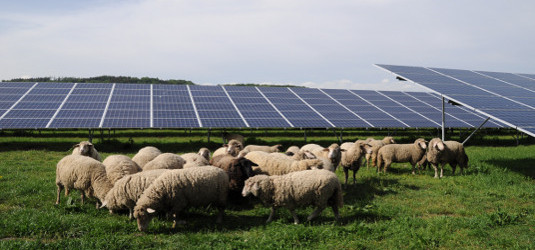Black sheep I: In a Bavarian solar farm, experts discovered overheated junction boxes after commissioning and, later, overheated plug connectors as well.
The prime contractor was willing to fix both defects. The crossed plug connectors from different manufacturers, which are relatively common in the PV farm, are still a headache for the operator.
In a solar farm, partly owned by a Bavarian citizens’ energy cooperative, there was a convergence of several power distribution problems. The farm, with a rated capacity of some 4.5 megawatts, was built in 2013 and performed as expected after commissioning. Nevertheless, the operator had the farm inspected after it went on line.
Hot collection boxes
The inspection also included an examination of the AC distribution boxes with a thermal camera. In the process, temperatures of some 100 degrees Celsius were measured at all of the installed fuses. The inspector noted the deficiency, and the prime contractor installed higher-rated fuses at its own cost. This reduced the temperature to a maximum initially measured value of 64 degrees Celsius. Calculations gave no reason to believe that temperatures would increase to much more than 70 degrees, and so the evaluator performing the assessment agreed to the solution.

Although another inspector measured a temperature of 73 degrees Celsius in a subsequent measurement on a hot day, the manufacturer presented documentation stating that the distribution cabinets could withstand temperatures of up to 300 degrees Celsius, so the inspector and operators’ association did not pursue the issue any further.
Hot plug connectors
It is customary to have a solar farm inspected by an expert again prior to the expiration of the warranty period. This was also the case at the citizens’ solar farm near Landshut some two years after commissioning. In the process, the inspector found two further irregularities. The first was another temperature problem.
At all of the inverter stations, there were several very hot plug connectors. The affected plug connectors and outgoing cables reached temperatures of well over 80 degrees Celsius. “The affected plug connectors were easy to identify because white spots had formed on the cables and plug connectors,” the operator explained. The inspector did not detect increased temperatures on identical plug connectors next to the affected ones. Overall, however, more than half of the plug connectors at the inverter stations were affected.
Hunting for clues with computed tomography
When the measurements were performed, the plug connectors, which were protected from direct sunlight, had loads not exceeding eight amperes, the inspector said. But the type of plug connectors used had a rated load capacity of up to 30 amperes. According to the inspector, a more detailed evaluation of the plug connectors indicated that the source of the overheating was the contact surface and not the crimping.
The exact cause of the problem
The plug connectors were then examined using computed tomography, a well known medial procedure. The examination determined that the contact surfaces were dirty. “They were tiny grains, scarcely visible to the human eye,” the operator said, adding that it was unclear whether the contamination was introduced in the manufacturing process or during installation. Whatever the source, the manufacturer delivered new connectors and the prime contractor shouldered the cost of the exchange. “If we hadn’t found the problem in time and exchanged all of the affected plug connectors, we would probably have regular problems with burnt out plugs,” the operator said.
Connectors from different manufacturers crossed
Another irregularity in the farm relates to the connection of the modules with the secondary cables leading to the junction boxes and inverters. the installed modules from a reputable manufacturer are equipped with several different types of plug made by different manufacturers. According to one of the evaluators, most of the module strings terminate with a mix of “MC4 compatible” plug connectors.
“Some manufacturers specifically state that a mix of plugs from different manufacturers is not permitted,” says the operator. He is therefore not entirely comfortable with this solution. After all, it is not clear whether these manufacturers still offer a warranty for their products when cross-connection is performed, which is expressly not approved.
The operator is therefore still unsure how to proceed on this issue. One of his problems is that the first inspector cited the cross connections as a deficiency and recommended their replacement. In subsequent evaluations, however, he retracted this recommendation. A second inspector, who evaluated the plant prior to the expiration of the warranty, again recommended replacing the incompatible plug connectors and referred to the original recommendation of the first evaluator.
Operator hesitant to go to court
“That is the dilemma. If I had a clear statement which we could enforce in a court of law, I would pursue that avenue,” says the operator. “But when a reputable evaluator says that the connections are tolerable under these conditions, then my desire for their replacement will be weighed against the word of the expert.” Uncertainty as to whether the legal process will ultimately be successful has made the operator hesitant to invest money in the expert evaluation required for the case, not to mention the potentially high legal costs.
This is particularly true, in view of the evaluator’s statement that replacing the plug connectors and solving the problem would only cost a few thousand euros.
According to the lawyer Andreas Kleefisch, one of whose specialties is solar law, it may very well be that the cross connections are not a valid deficiency. It is clear that the original evaluator initially characterized them as such and recommended their replacement.
“If, however, he was unable to detect any overheating in subsequent measurements and perhaps had a declaration of conformity to MC4 from the module manufacturer, and no other problems were anticipated, the connections are probably okay,” says Kleefisch. Of course in such cases it is unfortunate for the plant operator that the MC4 connector manufacturer Multi Contact does not warranty cross connections, he said.
Switching the connectors on the modules is not an ideal solution either because that voids the warranty on the modules. “If the purchase agreement for the modules does not explicitly state that original MC4 connectors have to be used, then there’s nothing you can do about it.”
“So far everything is working fine, but who knows what will happen in 10 or 15 years,” the operator says. “We’re keeping an eye on all of this. If at some point we determine that there are excessive temperatures there, we’ll have to exchange the connectors with current equipment at our own expense. But in future projects, he said he would make sure that only truly compatible plug connectors were used in any case.
Overall satisfied nevertheless
The operator would not characterize anyone involved as a black sheep. Both of the evaluators who carried out inspections attested that the PV farm was of generally high quality and well built. “There is no reason, to drag the prime contractor through the mud. 99.9% of our experience has been outstanding,” the operator said. He sees the cross connections of the plug connectors as a small fly in the ointment, which he hopes will not have any serious consequences. If another PV project should arise, he would definitely have no compunction about working with the same partners again.
Questions for discussion at our round table at Intersolar
· How should cross connections of plug connectors from different manufacturers be handled in PV plants?
· Can you rely on declarations from module manufacturers that various “compatible” plug types can be connected together? What should a reliable declaration of conformity look like?
· How hot can a generator junction box be?
· Should plug connectors generally be examined with a thermal imaging camera?
· How are problematic are dirty plug connectors?
This content is protected by copyright and may not be reused. If you want to cooperate with us and would like to reuse some of our content, please contact: editors@pv-magazine.com.








By submitting this form you agree to pv magazine using your data for the purposes of publishing your comment.
Your personal data will only be disclosed or otherwise transmitted to third parties for the purposes of spam filtering or if this is necessary for technical maintenance of the website. Any other transfer to third parties will not take place unless this is justified on the basis of applicable data protection regulations or if pv magazine is legally obliged to do so.
You may revoke this consent at any time with effect for the future, in which case your personal data will be deleted immediately. Otherwise, your data will be deleted if pv magazine has processed your request or the purpose of data storage is fulfilled.
Further information on data privacy can be found in our Data Protection Policy.